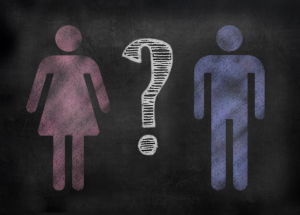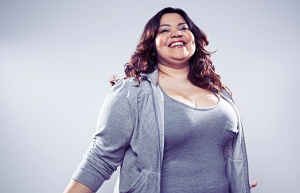(Content Warning: Transphobia, transmisogyny, sexual and physical assault, suicide, harassment, misgendering, non-consensual genital surgery, prejudice against intersex people)
Author’s Note: I want to recognize that not everyone whose assigned gender at birth differs from who they actually are identifies as trans. And not everyone who doesn’t fit solely into the categories of male and female uses the word “non-binary” for themselves. For this introductory article, I am using these words here.
I also want to name where I am coming from in this piece: I am a non-binary, genderfluid, genderqueer, white, middle-class, AFAB, thin person, and that affects my work, although I do my best to enrich my knowledge with other perspectives.
Let’s imagine that you know someone who is absolutely, 100%, drop-dead certain that every tall person is a basketball player.
They don’t ask the tall people they meet. They just assume. When they encounter tall people in public, they instantly think, “basketball player.”
If they meet a tall person, even before exchanging pleasantries like names and pronouns, they first ask, “So, how’s the basketball season going? Are you getting some good scores in?”
If the tall person is not actually a basketball player, they are faced with two uncomfortable options: pretending that they are a basketball player, or attempting to confront this stranger with reality.
Let’s say they try the second. “Uhhh… I know I’m tall, but I don’t actually play basketball.”
For the basketball fan, this is impossible: “What do you mean? Of course you do!”
So you, dear reader, might be thinking, “Well, this person is being a total tool! I mean, they should ask before making an assumption like that! You can’t just go assuming things about people based on their bodies!”
And you would be right.
However, once we bring the conversation over to a/gender identity, many people fail to understand the problem with instantly categorizing people as either male or female.
This is not surprising. Making this assumption is something we’ve been taught to do since birth. It’s deeply conditioned, even seen as polite.
But if we truly want to respect others, assuming a/gender identity makes little sense.
Gender, if you’re not agender, is something that is usually a deeper part of someone’s identity than a profession or sport – so we shouldn’t guess at it.
We are constantly forcing our assumptions about gender onto other people. And it’s making the world a more difficult and deadly place to be trans, non-binary, and gender non-conforming.
It’s also just generally making the world a more sexist place to be.
Constant, forced gendering is part of what makes the patriarchy so dangerous.
So, if you’re interested in feminism, for your own survival and the good of us all, you should be interested in this.
Why can’t you just assume others’ a/gender identities? The short answer is: because it’s rude, and can cause a lot of harm.
If you assume, you’re saying that you think you know someone else better than they know themselves.
This article is a guide to gender etiquette, especially when meeting new people.
First, we’re going to explore some common ways we’ve been taught to determine a/gender identity without asking, and why they are inaccurate, disrespectful, and/or ineffective.
Then, having deconstructed the presumptuous “politeness” we’ve been taught, we’ll talk about relearning politeness with simple strategies for addressing others respectfully.
Assumption #1: Primary Sex Characteristics Tell Me Who Someone Is
So. Let’s backtrack a bit.
Back to, you know, the day you were born (if it was in the present-day US), and someone in a white coat looked at your crotch and decided whether you were male or female (most likely).
They also may have potentially freaked out and operated on your genitalia – and then decided that this made you male or female.
That is many people’s first experiences with having their a/gender identity determined based on primary sex characteristics, or genitalia.
How’d that work out for you? Really, think about it for a moment.
Even if you’re cisgender and non-intersex, what’s it like for your identity to be reduced to what’s between your legs?
Because that’s what we’re really saying when we’re saying trans women can’t go to women’s colleges, when we’re saying they (and other people who are trans and/or intersex) can’t pee in public restrooms, when we’re denying them (and some others) access to domestic violence shelters.
We’re saying, not “men and women,” but “penises and vaginas.”
Hopefully most people aren’t asking others to drop their pants. Of course, with trans people, this form of politeness flies out the window, as many people feel entitled to inquire as to the state of our genitalia.
Let me be very clear: What’s between anyone’s legs doesn’t determine who they are. Our society likes to think so, but it’s just really creepy and misogynistic to think that way.
As cutequeer96 says, “‘[F]eminists’ who exclude trans women basically admit to seeing women as walking vaginas. [Y]ou know, like misogynists.”
Assumption #2: Secondary Sex Characteristics Determine Who Someone Is
Many people also like to determine a/gender identity based on others’ secondary sex characteristics, or what happens once many people hit puberty (however many puberties they may have had – or not).
During puberty, people often experience increased estrogen and/or testosterone in their bodies. This can result in facial hair, breasts, hips, an Adam’s apple, a lowered voice, and so on.
These things are simply part of someone’s body.
Our society has imposed gendered traits onto certain body parts and secondary sex characteristics. They actually are meaningless for determining that person’s a/gender identity.
Secondary sex characteristics may, of course, be quite meaningful to that person. Or not. But they certainly are none of your business!
Secondary sex characteristics can appear in many combinations, but only a few are socially accepted.
Someone can have a beard and breasts. They can have a penis and hips. They can have a lowered voice and a lengthened clitoris. Anybody who may have any of these things may be any – or no – gender.
What we definitely don’t need to do is decode what someone else’s relationship to their breasts, hips, beard, genitalia, and voice means for their a/gender identity.
Um, because that’s really creepy.
Assumption #3: Gender Expression Must Be a Sure Giveaway, Though
People sometimes like to say to me when I’m out in my glittery state, “If you’re not a girl, why do you dress like one? Seems like a waste of effort. Why not just stay a girl?”
I usually spare such ignorance the monologue about how I realized I (sometimes) loved glittery, glam, and ruffly clothes only after I accepted that I wasn’t a girl. Before then, I avoided those things – precisely because it was “girl stuff.”
Because of assumptions about gender expression being the same as gender identity, I’d missed out on a whole universe of expression that made me happy!
The shoes, shirts, pants, skirts, scarves, necklaces, makeup, hats, and so on that you put on, the way that you talk, the way that you walk – none of these things determine a/gender identity.
They can interact with your a/gender identity. They might help to inform it. But they are not your a/gender identity. They are how you express yourself.
Some people like to say, “You can usually tell what someone’s getting at by how they present themselves.”
No. No, you actually can’t. Clothes are fabric. They aren’t gender.
Assumption #4: Name and Pronouns Must Indicate Someone’s A/Gender Identity
“Okay, okay,” I can imagine you saying. “So. I got it. I can’t figure out someone’s a/gender identity by their body or clothes.”
“But, I mean, their name usually is a giveaway! And if not their name, at least their pronouns are!”
I love to hate to burst your bubble, but even this is not the final determiner of someone’s a/gender identity.
Anyone with any identity might have a name or pronouns (or lack of pronouns) that usually belongs to a certain gender.
Trans people might keep their birth name for all sorts of reasons. And sometimes people intentionally use a name that doesn’t match stereotypical expectations. Or sometimes a name just is awesome!
Some non-binary people use pronouns like he/him/his and she/her/hers. It doesn’t mean that they suddenly are in the gender binary. Some people use no pronouns at all, or use a variety of pronouns, or other pronouns, for any number of reasons.
Really, the only thing that someone’s name and pronouns (or lack of pronouns) tell you is what that person wants to be called, by you, right now.
Luckily for you, that’s probably all you need to know!
The person you’re meeting can share more with you at their leisure – or not at all.
That’s right: Actually, you don’t even “need” to know someone’s a/gender identity at all. In order to be respectful, all you need to know is their name and pronouns.
Relearning Politeness, Part 1: Acting in Solidarity
We constantly categorize people, constantly “need” to know the a/gender identities of other people in our lives.
Actually, scratch that. We are imposing our ideas about gender on people.
Because if we were genuinely wondering, society would teach us to ask, rather than decide for others who they must be.
But it doesn’t. Not yet. You can join the people pushing to make that change.
Contrary to popular belief that appearing cis is the best compliment you can give someone, asking for pronouns is the most polite way to go about your interactions. Because it’s a whole lot ruder to assume something so basic about someone’s identity.
In fact, you risk harassing someone. Because misgendering someone (using the wrong pronouns for them without correcting yourself) is harassment.
Misgendering contributes to trans people experiencing fear and invalidation, physical attacks, and suicidal thoughts. Don’t be that person.
This is not the only thing you can do in solidarity with trans people. It isn’t even the most important thing. (Fighting against our immediate deaths, assaults, employment discrimination/unemployment, and homelessness is definitely more important.)
But it is a straightforward thing you can do, and one that costs you less than it costs the trans people around you.
Relearning Politeness, Part 2: Cis Privilege and Trans Safety
In an ideal world, asking for people’s pronouns will be as straightforward as asking someone’s name, and the answer will be as safe and nonchalant – and respected.
Of course, here on Earth, this’s not always the case. And this is where I want you to believe me when I say cis privilege is at play here.
Changing cissexist norms is intimidating. But giving in to those norms is a part of cis privilege.
No matter how nervous or awkward you feel, if you are cis, I guarantee you that you are waaay safer than a trans person when asking or answering this question.
Asking may feel strange at first, but systematic erasure and discrimination is definitely stranger. And more awkward.
(Social anxiety and other disabilities, as well as intersecting oppressions, can play a real role in your capacity for doing this. I am talking about asking as you are able.)
There may still be times when you’re not safe in terms of asking this question. Please do prioritize safety.
But I want to challenge you to consider when it’s a lack of safety and when it’s simply an unwillingness to challenge a social norm.
Relearning Politeness, Part 3: Keep Things Neutral
So, how can we find out the information we need to refer to someone? How can we make the shift from invasive assumptions to basic respect?
Before we talk about specific things you can do, here’s the key: It’s only respectful if it’s something you do with everyone, not just those who you “aren’t sure” about.
This is because we always should be unsure – there is no one way to “look trans.”
You can follow this first new etiquette guideline nearly all the time, even if you are concerned about safety.
Refrain from using any pronouns (or other gendered words) for people until there’s a quiet/private chance to ask. Only use gendered language for other people if and when you know what words they use.
Otherwise, keep it neutral.
Relearning Politeness, Part 4: Ask for Pronouns
There are many ways to ask for pronouns. The most straightforward way is to ask people’s pronouns along with their names. You could say something like, “I want to be sure that I refer to everyone in my life respectfully. What pronouns, if any, do you use?”
Or you could introduce yourself with your name and your pronouns: “Hi, my name is Adrian, and I use they/them/their pronouns. What’s your name and, if you use them, pronouns?”
Put your name and your pronouns on nametags. Basically, whenever you are using your name in a new setting, make sure your pronouns (if you use them) are glued to it. This will help set the standard.
And once you ask for people’s pronouns, make sure you use them. Here are some resources for pronoun etiquette.
***
We need to toss the idea that you can decide someone else’s identity without asking them. Because we can’t.
Why do so many people want to know other people’s a/gender identities?
A lot of this has to do with them wanting to know how to treat others. But apart from consensually affirming other people’s identities, deciding how to treat others based on their a/gender identity is sexist.
So, for the love of trans people, and for the love of feminism, let’s make this happen.
It will make us all safer.
[do_widget id=”text-101″]
Adrian Ballou is a Contributing Writer for Everyday Feminism. A genderqueer writer, artist, activist, and educator who does youth development work both inside and outside the classroom, they particularly enjoy writing and facilitating social justice education and youth organizing curriculum. To learn more about their consulting and speaking work, check them out here. In their free time, they cook lots of food, sing songs, make art, and practice their Spanish, Hindi, and Urdu. Read their articles here.
Search our 3000+ articles!
Read our articles about:
Our online racial justice training
Used by hundreds of universities, non-profits, and businesses.
Click to learn more





















